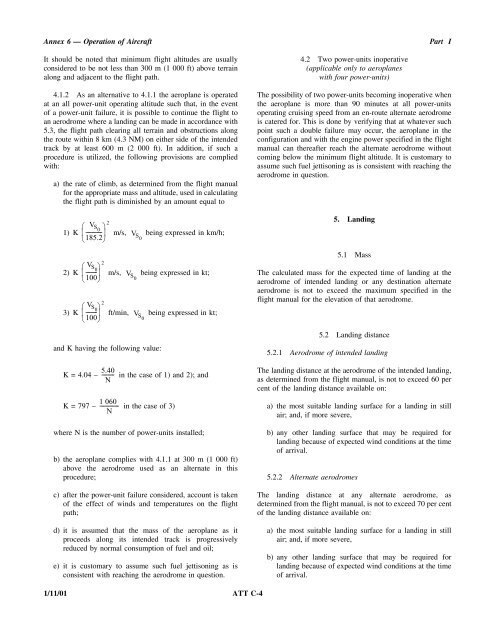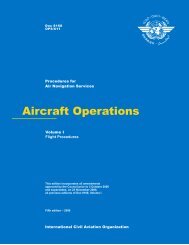Operation of Aircraft
Annex 6, Part I
Annex 6, Part I
- No tags were found...
Create successful ePaper yourself
Turn your PDF publications into a flip-book with our unique Google optimized e-Paper software.
Annex 6 — <strong>Operation</strong> <strong>of</strong> <strong>Aircraft</strong><br />
Part I<br />
It should be noted that minimum flight altitudes are usually<br />
considered to be not less than 300 m (1 000 ft) above terrain<br />
along and adjacent to the flight path.<br />
4.1.2 As an alternative to 4.1.1 the aeroplane is operated<br />
at an all power-unit operating altitude such that, in the event<br />
<strong>of</strong> a power-unit failure, it is possible to continue the flight to<br />
an aerodrome where a landing can be made in accordance with<br />
5.3, the flight path clearing all terrain and obstructions along<br />
the route within 8 km (4.3 NM) on either side <strong>of</strong> the intended<br />
track by at least 600 m (2 000 ft). In addition, if such a<br />
procedure is utilized, the following provisions are complied<br />
with:<br />
a) the rate <strong>of</strong> climb, as determined from the flight manual<br />
for the appropriate mass and altitude, used in calculating<br />
the flight path is diminished by an amount equal to<br />
V S0<br />
⎛ ⎞ 2<br />
1) K ⎜------------<br />
⎟ m/s, V being expressed in km/h;<br />
⎝185.2<br />
S0<br />
⎠<br />
4.2 Two power-units inoperative<br />
(applicable only to aeroplanes<br />
with four power-units)<br />
The possibility <strong>of</strong> two power-units becoming inoperative when<br />
the aeroplane is more than 90 minutes at all power-units<br />
operating cruising speed from an en-route alternate aerodrome<br />
is catered for. This is done by verifying that at whatever such<br />
point such a double failure may occur, the aeroplane in the<br />
configuration and with the engine power specified in the flight<br />
manual can thereafter reach the alternate aerodrome without<br />
coming below the minimum flight altitude. It is customary to<br />
assume such fuel jettisoning as is consistent with reaching the<br />
aerodrome in question.<br />
5. Landing<br />
5.1 Mass<br />
V S0<br />
⎛ ⎞ 2<br />
2) K ⎜--------<br />
⎟ m/s, V being expressed in kt;<br />
⎝100<br />
S0<br />
⎠<br />
V S0<br />
⎛ ⎞ 2<br />
3) K ⎜--------<br />
⎟ ft/min, V being expressed in kt;<br />
⎝100<br />
S0<br />
⎠<br />
and K having the following value:<br />
K = 4.04 –<br />
5.40<br />
---------<br />
N<br />
in the case <strong>of</strong> 1) and 2); and<br />
1<br />
K = 797 – --------------<br />
060<br />
in the case <strong>of</strong> 3)<br />
N<br />
where N is the number <strong>of</strong> power-units installed;<br />
b) the aeroplane complies with 4.1.1 at 300 m (1 000 ft)<br />
above the aerodrome used as an alternate in this<br />
procedure;<br />
c) after the power-unit failure considered, account is taken<br />
<strong>of</strong> the effect <strong>of</strong> winds and temperatures on the flight<br />
path;<br />
d) it is assumed that the mass <strong>of</strong> the aeroplane as it<br />
proceeds along its intended track is progressively<br />
reduced by normal consumption <strong>of</strong> fuel and oil;<br />
e) it is customary to assume such fuel jettisoning as is<br />
consistent with reaching the aerodrome in question.<br />
The calculated mass for the expected time <strong>of</strong> landing at the<br />
aerodrome <strong>of</strong> intended landing or any destination alternate<br />
aerodrome is not to exceed the maximum specified in the<br />
flight manual for the elevation <strong>of</strong> that aerodrome.<br />
5.2 Landing distance<br />
5.2.1 Aerodrome <strong>of</strong> intended landing<br />
The landing distance at the aerodrome <strong>of</strong> the intended landing,<br />
as determined from the flight manual, is not to exceed 60 per<br />
cent <strong>of</strong> the landing distance available on:<br />
a) the most suitable landing surface for a landing in still<br />
air; and, if more severe,<br />
b) any other landing surface that may be required for<br />
landing because <strong>of</strong> expected wind conditions at the time<br />
<strong>of</strong> arrival.<br />
5.2.2 Alternate aerodromes<br />
The landing distance at any alternate aerodrome, as<br />
determined from the flight manual, is not to exceed 70 per cent<br />
<strong>of</strong> the landing distance available on:<br />
a) the most suitable landing surface for a landing in still<br />
air; and, if more severe,<br />
b) any other landing surface that may be required for<br />
landing because <strong>of</strong> expected wind conditions at the time<br />
<strong>of</strong> arrival.<br />
1/11/01 ATT C-4












